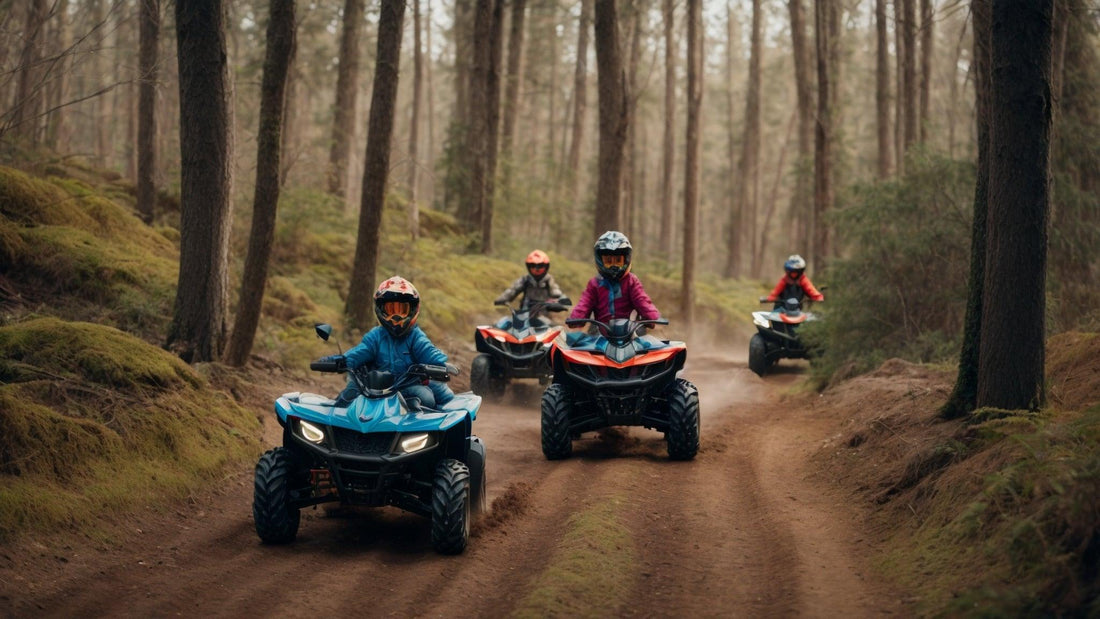
Advice for Parents Looking to Get Their Kid an ATV
Q9powersportsusa.com StaffShare
Gas Powered Kids ATVs come in all sizes
If you're a parent considering getting your kid an ATV (All-Terrain Vehicle), it's important to make an informed decision. ATVs can provide a thrilling outdoor experience for children, but safety should always be the top priority. This article aims to provide you with some valuable advice when it comes to choosing the right ATV for your child, ensuring their safety, and promoting responsible riding.
1. Age and Size Recommendations
Before purchasing an ATV, it's crucial to consider the age and size recommendations provided by the manufacturer. Different ATVs are designed for various age groups, so make sure you select one that is suitable for your child's age and physical capabilities. Purchasing an ATV that is too large or powerful for your child can be dangerous.
2. Safety Gear
Investing in proper safety gear is essential when your child rides an ATV. Make sure your child always wears a helmet, goggles, gloves, long sleeves, long pants, and sturdy boots. This gear will protect them from potential injuries and ensure a safer riding experience.
3. Training and Supervision
Before your child starts riding an ATV, ensure they receive proper training. Enroll them in an ATV safety course or seek guidance from an experienced rider. It's important to teach your child about the rules of the road, safe riding techniques, and how to handle emergency situations. Always supervise your child while they are riding and gradually increase their riding privileges as they gain experience and demonstrate responsible behavior.
4. Maintenance and Inspection
Regular maintenance and inspections are essential to ensure the ATV is in proper working condition. Check the brakes, tires, and other components regularly. Teach your child basic maintenance tasks, such as checking the oil level and cleaning the air filter. By instilling these habits early on, you'll help your child develop a sense of responsibility towards their ATV.
5. Setting Boundaries
Establish clear boundaries for where your child can ride their ATV. Designate specific areas or tracks where they can safely enjoy their ATV. Ensure they understand the importance of staying away from public roads, unfamiliar terrains, and areas with potential hazards. Setting boundaries will help keep your child safe and reduce the risk of accidents.
6. Leading by Example
As a parent, it's important to lead by example when it comes to ATV safety. Always wear safety gear when riding your own ATV and follow the rules of the road. Your child is more likely to adopt safe riding habits if they see you practicing them consistently.
7. Risk Assessment
Before allowing your child to ride an ATV, assess their readiness and maturity level. Consider their ability to follow instructions, understand the risks involved, and make responsible decisions. Some children may need more time to develop the necessary skills and judgment to ride an ATV safely.
8. Communication and Education
Openly communicate with your child about the importance of ATV safety. Explain the potential risks and consequences of unsafe riding behavior. Encourage them to ask questions and address any concerns they may have. Education and awareness are key to ensuring your child understands the importance of responsible ATV riding.
9. Regular Safety Checks
Before each ride, conduct a safety check of the ATV. Ensure that all the lights, brakes, and controls are functioning properly. Check the tire pressure and fuel level. By making safety checks a routine, you reduce the risk of mechanical failures that could lead to accidents.
10. Weather Conditions
Teach your child to consider weather conditions before riding their ATV. Avoid riding during heavy rain, snow, or strong winds, as these conditions can make the terrain more hazardous and decrease visibility. Make sure your child understands that their safety is more important than the thrill of riding in unfavorable weather.
11. Proper Riding Technique
Teach your child the proper riding techniques to ensure their safety. This includes maintaining a proper riding posture, keeping their feet on the footrests, and using the brakes correctly. Emphasize the importance of not performing stunts or riding recklessly, as these behaviors increase the risk of accidents.
12. ATV Size and Power
Consider the size and power of the Youth ATV based on your child's physical capabilities. A smaller ATV with lower power may be more suitable for younger children or beginners. As your child grows and gains experience, you can gradually upgrade to a larger and more powerful ATV.
13. Local Laws and Regulations
Familiarize yourself with the local laws and regulations regarding ATV usage in your area. Some locations may have age restrictions or specific requirements for riding ATVs. Make sure you adhere to these rules to avoid legal issues and ensure the safety of your child.
14. Emergency Preparedness
Prepare your child for emergency situations that may arise while riding an ATV. Teach them how to handle a breakdown or an accident, including how to call for help and administer basic first aid. Ensure they have a basic understanding of how to navigate through different terrains and obstacles they may encounter.
Conclusion
Getting your kid an ATV can be an exciting experience, but safety should always come first. By considering age and size recommendations, investing in proper safety gear, providing training and supervision, conducting regular maintenance and inspections, setting boundaries, leading by example, assessing readiness, promoting communication and education, performing safety checks, considering weather conditions, teaching proper riding techniques, choosing the right ATV size and power, understanding local laws and regulations, and preparing for emergencies, you can ensure your child has a safe and enjoyable ATV riding experience. Remember, responsible riding starts with informed parents.
